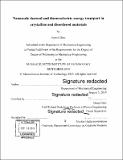Nanoscale thermal and thermoelectric energy transport in crystalline and disordered materials
Author(s)
Zhou, Jiawei.
Download1139520352-MIT.pdf (20.90Mb)
Other Contributors
Massachusetts Institute of Technology. Department of Mechanical Engineering.
Advisor
Gang Chen.
Terms of use
Metadata
Show full item recordAbstract
Energy transport provides the fundamental basis for operation of devices from transistors to solar cells. Despite past theories that successfully illustrate the principles behind the energy transport based on solid state physics, the microscopic details of the energy transport are not always clear due to the lack of tool to quantify the contribution from different degrees of freedom. Recent progress in first principles computations and development in optical characterization has offered us new ways to understand the energy transport at the nanoscale in a quantitative way. In this thesis, by leveraging these techniques, we aim to providing a detailed understanding of thermal and thermoelectric energy transport in crystalline and disordered materials, especially about how the energy transport depends on atomistic level details such as chemical bondings. Specifically, we will discuss three examples. 1) Electron transport in semiconductors: how electrons propagate as they interact with lattice and impurities. 2) Interaction between charge and heat: how the free carriers have an impact on the heat dissipation in semiconductors 3) Heat conduction in polymers: how the heat transfer in an amorphous system depends on its molecular structures. In the case of electron transport, we developed and applied first principles simulation to show that a large electron mobility can benefit from symmetry-protected non-bonding orbitals. Such orbitals result in weak electron-lattice coupling that explains the unusually large power factors in half-Heusler materials - a good thermoelectric material system. By devising an optical experiment to probe the ultrafast thermal decay, we quantified the effect of electron-phonon interaction on the thermal transport. Our results show that the thermal conductivity can be significantly affected by the free carriers. Lastly, we built a theoretical model to understand the heat conduction in amorphous polymers, and used this knowledge to design materials that are heat-conducting yet soft. These understandings will potentially facilitate discovery of new material systems with beneficial charge and heat transport characteristic.
Description
Thesis: Ph. D., Massachusetts Institute of Technology, Department of Mechanical Engineering, 2019 Cataloged from PDF version of thesis. Includes bibliographical references (pages 133-142).
Date issued
2019Department
Massachusetts Institute of Technology. Department of Mechanical EngineeringPublisher
Massachusetts Institute of Technology
Keywords
Mechanical Engineering.